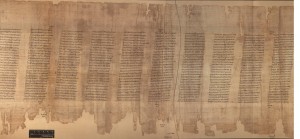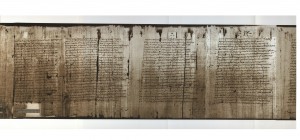For much of antiquity, the scroll was the fundamental unit of literary transmission.
The Greeks and Romans used scrolls from the introduction of writing in around the 8th-6th centuries all the way through approximately the 4th century when they moved on to the codex.
Consequently, a great way to explore the culture and practices surrounding the ancient literary world is to create one for yourself!
The Anatomy of a Scroll
Before making a scroll, it is best to become familiar with the terminology of how they are constructed. The key parts of a scroll are the recto, verso, kollema, and kollesis.
Because of the manner in which they are made, sheets of papyrus typically have two different sides – one with fibers running horizontally, and the other with fibers running vertically. The ‘recto’ is the side with horizontal fibers. The recto is typically the interior, writing, side of the papyrus. The ‘verso’ is the side of the papyrus with vertical fibers. The verso is typically the outside of the roll. This is because the vertical fibers are more flexible, pulling apart slightly when the scroll is curved with them on the outside. Since they can separate as they are bent, it is easier and less damaging to the scroll to roll it with them on the outside.

Since scrolls are made up of many individual sheets of papyrus fixed together, there are special names for these parts of the roll as well. The term ‘kollema’ refers to a single sheet of papyrus out of the entire assembled scroll. A ‘kollesis’ is the join between kollema, or, in other words, the place where the individual sheets that make up a scroll have been glued together.
It is also helpful to be familiar with the measurements of scrolls. For this reconstruction, I use sheets of papyrus cut to a size of approximately 8.5in x 11in since this falls within the range of authentic ancient dimensions. In antiquity, based on the data presented by William Johnson in Bookrolls and Scribes in Oxyrhynchus, kollema dimensions could have been on average anywhere from roughly 8in to 10in in width and up to 12in in height, depending on era, region, and other factors.

Materials
For this project, I use papyrus purchased online for around one to two dollars per sheet. If you are unable to purchase real papyrus paper, you can also use construction paper, paper towels, brown bag paper, or any number of other such materials to make your scroll sheets.
To glue the sheets together, I brush on simple Elmer’s glue, but any glue you have should work just fine. In antiquity, a similarly simple glue would have been used to attach kollema and assemble scrolls.
How to Make a Scroll
Helpful Links:
To learn more about papyrus - Papyrus: A Brief History
To buy papyrus - Kemet Art 8x12 Papyrus
For more on the history of scrolls - The Historical Background of The Ancient Scroll
To learn about the scripts that would have been written on scrolls - Ancient Scripts: Rustic Capitals, Old and New Roman Cursive
Bibliography
Bagnall, Roger S. The Oxford Handbook of Papyrology. New York: Oxford UP, 2011. Print.
- Information on the use, manufacture, sale, and general structure of scrolls taken from Chapter One: Writing Materials in the Ancient World
- More detailed information on the above taken from Chapter Eleven: The Ancient Book
Johnson, William A. Bookrolls and Scribes in Oxyrhynchus. Toronto: U of Toronto, 2004. Print.
- For more on the more technical information concerning the construction and measurements of scrolls, as well as the images featured in this post
Tsuneishi, Monica. "Papyrus Glossary." University of Michigan Library. University of Michigan, 11 Mar. 2014. Web. <http://www.lib.umich.edu/papyrology-collection/papyrus-glossary>.
- For more on papyrological definitions see the University of Michigan’s online papyrological glossary
Thanks. Fascinating!
Very cool! Awesome idea for mailing letters! Then put your seal on it.
one of the best egyptian led screens advertisning , led outdoors , led indoors brothersgroup.co
Pingback: Mitä oli ennen kuin Raamattu oli Raamattu – Sosiaalisten identiteettien välittyminen juutalaisuudessa, kristinuskossa ja islamissa
What is the part called that the scroll rolls up on? It's usually a set of wood cylinders like a pair of rolling pins? Sorry I'm new.
Pingback: Rex Codex: Why did Christians prefer the codex over the scroll? – Introduction to the New Testament
Мебель - це важливий елемент нашого інтер'єру, який надає комфорт, організацію та стиль нашим просторам. Вона може бути зручною для сидіння та відпочинку, служити для зберігання речей, визначати стиль приміщення та відображати наші потреби та смаки. Якість та вибір мебелі важливі для створення затишного та функціонального інтер'єру. мебель эверест
тумба прикроватная Эверест
пеленальный комод эверест
Стол компьютерный Мини ультра Эверест
меблі Еверест
купить мебель эверест
Great post thank you. Please visit our website: SEO content writing